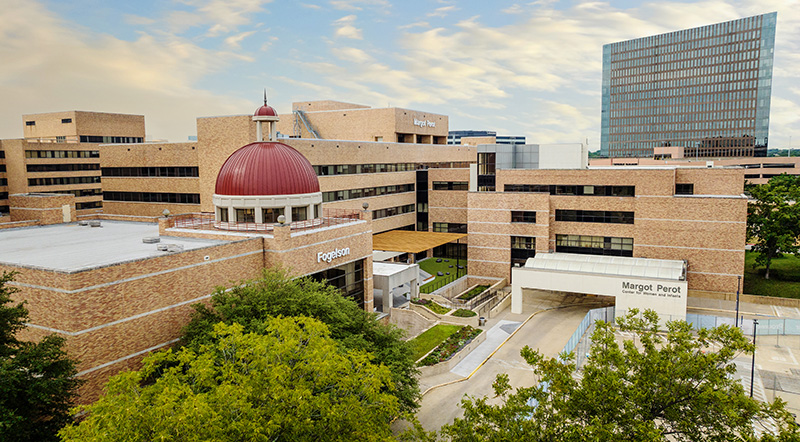As technology advances, so do the surgical techniques used by physicians to care for patients. Utilizing sophisticated robotic surgical systems such as da Vinci, Mako SmartRobotics™, or the Levita Magnetic Surgical System® (MARS), surgeons can perform complex procedures minimally invasively with enhanced precision, flexibility, and control. Multiple Texas Health facilities have acquired the new da Vinci 5, which features more than 150 new enhancements developed to support surgeon autonomy and care team efficiency with the goal of improving patient outcomes.
How Robotic-Assisted Surgery Works
During a procedure, a specially trained surgeon will sit at an operating console and control a small 3D, high-definition camera and the robotic arms that hold surgical instruments while viewing the surgical site on a monitor. The surgeon is in control of the robot during the entire procedure, operating from the console, which translates their hand movements into precise actions of the surgical instruments attached to the robotic arms. Instead of a large incision used in traditional open surgery, a single small incision or a few small incisions can be made, usually only one to two centimeters in length, where the camera and instruments are inserted.
Benefits of Robotic Surgery
There are many potential benefits of robotic surgery for patients due to the minimally invasive nature of robotic procedures:
- Smaller incisions compared to traditional open surgery, which can lead to less scaring, quicker recovery times, and lower risk of infection.
- Reduced post-operative pain/discomfort, blood loss, postoperative hernias, and trauma to the body due to smaller incisions.
- Shorter hospital stays and a quicker return to normal activities.
Types of Robotic Surgery
Robotic-assisted surgery can be used for a variety of procedures, offering innovative solutions for various conditions some of which include:
- Bariatric surgery - including sleeve gastrectomy and gastric bypass
- Colorectal surgery
- Gastrointestinal surgery - including esophageal and stomach procedures
- General surgery - including hernia surgery, appendectomy, and gallbladder removal
- Gynecological surgery - including removal of ovaries, endometriosis, fibroids, or Hysterectomy
- Heart and vascular surgery – including heart valve repair and replacement and coronary artery bypass grafting (CABG)
- Lung cancer/thoracic surgery
- Orthopedic surgery - including joint replacement
- Transplant surgery
- Urologic surgery - including pelvic organ prolapse
Robotic surgery continues to evolve and transform surgical care for patients and physicians who benefit from safer, more effective surgical options. Discuss with your surgeon if minimally invasive robotic surgery is an option for you.

-
Robotic Surgery (Texas Health Fort Worth)
 Texas Health Harris Methodist Hospital Fort Worth earned accreditation from Surgical Review Corporation (SRC) as a Center of Excellence in Robotic Surgery, which recognizes the hospital’s commitment to high quality patient care and safety. For patients undergoing common or complex robotic procedures including general, colorectal, gynecological, thoracic, and urologic surgeries, this accreditation emphasizes a dedication to surgical training, education, and advancement.
Texas Health Harris Methodist Hospital Fort Worth earned accreditation from Surgical Review Corporation (SRC) as a Center of Excellence in Robotic Surgery, which recognizes the hospital’s commitment to high quality patient care and safety. For patients undergoing common or complex robotic procedures including general, colorectal, gynecological, thoracic, and urologic surgeries, this accreditation emphasizes a dedication to surgical training, education, and advancement.SRC also recognizes surgeons on the medical staff at Texas Health Fort Worth as Accredited Surgeons of Excellence in Robotic Surgery for completing additional training and program requirements.
-
Women's Robotic Surgery (Texas Health Dallas)
 The Women's Robotic Surgery program at Texas Health Presbyterian Hospital Dallas has earned prestigious accreditation as a Center of Excellence in Robotic Surgery by the Surgical Review Center (SRC). The accreditation emphasizes a dedication to surgical training, education, and advancement for a range of procedures including:
The Women's Robotic Surgery program at Texas Health Presbyterian Hospital Dallas has earned prestigious accreditation as a Center of Excellence in Robotic Surgery by the Surgical Review Center (SRC). The accreditation emphasizes a dedication to surgical training, education, and advancement for a range of procedures including:- Hysterectomy
- Myomectomy
- Complex endometriosis resection
- Pelvic organ prolapse
- Abdominal cerclage






